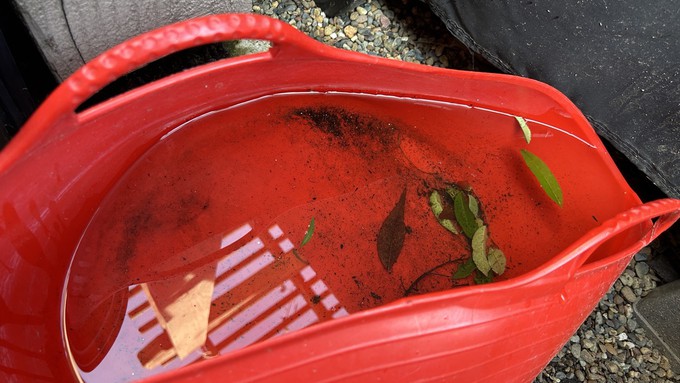
Trees got a good, deep soaking from recent 'atmospheric rivers'

The recent storms left behind a lot of water, but not too much for our soil to hold. (To guard against mosquitoes, be sure to empty any buckets and saucers of water before it warms up again.) Kathy Morrison
When it came to our latest atmospheric rivers, Sacramento found a sweet spot: Good steady rain with a chance to sink in.
In the first eight days of February, Downtown Sacramento received 2.15 inches of rain – double the average for that period, says the National Weather Service. That includes just over an inch during the storm that hit Sunday-Monday, Feb. 4-5, and another half inch on Wednesday, Feb. 7.
As a whole, Sacramento County collection sites averaged 3.32 inches for the first seven days of February, says the weather service. Our second rainiest month behind January, February normally totals 3.59 inches.
Most of that rain had a chance to soak in, replenishing reserves for our suburban forest and landscapes as well as local orchards. That’s good news for trees as they continue to recover from years of drought.
Some communities – particularly those closer to the Bay Area – have been even wetter this month. Davis, for example, recorded 4.13 inches in those first eight days – almost 3 inches above normal.
Locally, wind caused more issues than rain. The strong gusts that accompanied Sunday’s precipitation knocked over dozens of trees (and brought down lots of limbs) as well as many fences. But the local destruction was light compared to last winter’s storms that uprooted hundreds of drought-weakened trees in Sacramento and surrounding cities.
Elsewhere around California, this week’s storms took a heavy toll, causing flooding and mudslides. Long Beach (my hometown) totaled more than 10 inches Feb. 1-7; normal for that week is 0.79. That includes a record 3.16 inches on Tuesday, Feb. 6. Long Beach rarely gets more than 10 inches of rain in an entire year.
All this rain has prompted a wet outlook for our state’s water year. No drought is in the picture, says the National Integrated Drought Information System. (Find its localized data at https://www.drought.gov/.)
NIDIS expects our precipitation to continue to track high. The forecast calls for “60 to 70% probability of above normal precipitation” for the rest of February and “100 to 150% of normal precipitation” for the next 60 days.
Meanwhile, enjoy a sunny break in the weather. Sacramento’s next chance of showers is Thursday, Feb. 15.
More on local weather: https://www.weather.gov/sto/#
Comments
0 comments have been posted.Sacramento Digs Gardening to your inbox.
Sites We Like
Garden Checklist for week of May 5
Survey your garden after the May 4 rainstorm. Heavy rain and gusty winds can break the neck of large flowers such as roses. Also:
* Keep an eye on new transplants or seedlings; they could take a pounding from the rain.
* Watch out for powdery mildew. Warmth following moist conditions can cause this fungal disease to “bloom,” too. If you see a leaf that looks like it’s dusted with powdered sugar, snip it off.
* After the storm, start setting out tomato transplants, but wait on the peppers and eggplants (they want warmer nights). Pinch off any flowers on new transplants to make them concentrate on establishing roots instead of setting premature fruit.
* Trim dead flowers but not leaves from spring-flowering bulbs such as daffodils and tulips. Those leaves gather energy to create next year's flowers. Also, give the bulbs a fertilizer boost after bloom.
* Pinch chrysanthemums back to 12 inches for fall flowers. Cut old stems to the ground.
* Mulch around plants to conserve moisture and control weeds.
* From seed, plant beans, beets, cantaloupes, carrots, corn, cucumbers, melons, pumpkins, radishes and squash.
* Plant onion sets.
* In the flower garden, plant seeds for asters, cosmos, celosia, marigolds, salvia, sunflowers and zinnias. Transplant petunias, zinnias, geraniums and other summer bloomers.
* Plant perennials and dahlia tubers for summer bloom.
* Don’t wait; plant summer bulbs, such as gladiolus and tuberous begonias.
* Harvest cabbage, lettuce, peas and green onions.